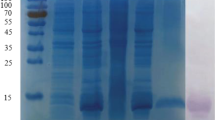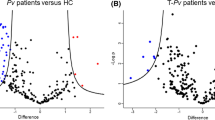Abstract
Ancylostoma ceylanicum is a zoonotic parasitic nematode that can cause iron-deficiency anemia and malnutrition in humans. A. ceylanicum hookworm platelet inhibitor (Ace-HPI) can inhibit platelet aggregation in the host to facilitate blood sucking, but whether it possesses platelet adhesion inhibitory activity or immunomodulatory role is yet unknown. To explore the effect of Ace-HPI on platelet adhesion, we expressed the recombinant protein in two competent cells, BL21 (DE3) and Rosetta-gami2 (DE3), and incubated this protein with canine platelets in a 96-well microplate. Ace-HPI was used to stimulate peripheral blood mononuclear cells (PBMC) in vitro to investigate the effect on PBMC proliferation and cytokine expression. Results showed that Ace-HPI expressed in Rosetta-gami2 (DE3) strain was mostly soluble. The inhibitory effect of this protein on platelet adhesion was relatively weak (7–8%). This protein stimulated the proliferation of PBMC and promoted the expression of Treg and Th2 cytokines, such as IL-10 and IL-13. These results lay a foundation for exploring the role of Ace-HPI in hookworm disease pathogenesis and as a candidate molecule for hookworm vaccines.



Similar content being viewed by others
References
Bellavite P, Andrioli G, Guzzo P, Arigliano P, Chirumbolo S, Manzato F, Santonastaso C (1994) A colorimetric method for the measurement of platelet adhesion in microtiter plates. Anal Biochem 216(2):444–450
Calvete JJ (1995) On the structure and function of platelet integrin αIIbβ3, the fibrinogen receptor. Proc Soc Exp Biol Med 208:346–360
Calvo E, Tokumasu F, Marinotti O, Villeval JL, Ribeiro JM, Francischetti IM (2007) Aegyptin, a novel mosquito salivary gland protein, specifically binds to collagen and prevents its interaction with platelet glycoprotein VI, integrin α2β1, and von Willebrand factor. J Biol Chem 282(37):26928–26938
Chadderdon RC, Cappello M (1999) The hookworm platelet inhibitor: functional blockade of integrins GPIIb/IIIa (αIIbβ3) and GPIa/IIa (α2β1) inhibits platelet aggregation and adhesion in vitro. J Infect Dis 179(5):1235–1241
Chen J, Xu M, Zhou DH, Song HQ, Wang CR, Zhu XQ (2012) Canine and feline parasitic zoonoses in China. Parasite Vector 5(1):152
Connolly TM, Jacobs JW, Condra C (1992) An inhibitor of collagen-stimulated platelet activation from the salivary glands of the Haementeria officinalis leech. I. Identification, isolation, and characterization. J Biol Chem 267(10):6893–6898
de Silva NRD, Brooker S, Hotez PJ, Montresor A, Engels D, Savioli L (2003) Soil-transmitted helminth infections: updating the global picture. Trends Parasitol 19(12):547–551
Deckmyn H, Stassen JM, Vreys I, Van Houtte E, Sawyer RT, Vermylen J (1995) Calin from Hirudo medicinalis, an inhibitor of platelet adhesion to collagen, prevents platelet-rich thrombosis in hamsters. Blood 85(3):712–719
Del Valle A, Jones BF, Harrison LM, Chadderdon RC, Cappello M (2003) Isolation and molecular cloning of a secreted hookworm platelet inhibitor from adult Ancylostoma caninum. Mol Biochem Parasitol 129:167–177
Du X, Ginsberg MH (1997) Integrin alpha IIb beta 3 and platelet function. Thromb Haemost 78:96–100
Furtado LFV, Dias LT, Rodrigues T, da Silva VJ, Gomes VN, de Oliveira M, Rabelo ML (2020) Egg genotyping reveals the possibility of patent Ancylostoma caninum infection in human intestine. Sci Rep 10:3006
Gan W, Deng L, Yang C, He Q, Hu J, Yin H, Peng L (2009) An anticoagulant peptide from the human hookworm, Ancylostoma duodenale that inhibits coagulation factors Xa and XIa. FEBS Lett 583(12):1976–1980
Graham M, Smith TS, Munn EA, Knox DP, Oliver JJ, Newton SE (2000) U.S. Patent No. 6,066,503. Washington, DC: U.S. Patent and Trademark Office
Hotez PJ, Bethony J, Bottazzi ME, Simon B, Paulo B (2005) Hookworm: “The great infection of mankind”. PLoS Med 2(3):e67
Huang Y, Abuzeid AMI, Liu Y, He L, Zhao Q, Yan X, Liu J, Li G (2020) Identification and localization of hookworm platelet inhibitor in Ancylostoma ceylanicum. Infect Genet Evol 77:104102
Karczewski J, Waxman L, Endris RG, Connolly TM (1995) An inhibitor from the Argasid tick Ornithodoros moubata of cell adhesion to collagen. Biochem Bioph Res Co 208(2):532–541
Keller PM, Schultz LD, Condra C, Karczewski J, Connolly TM (1992) An inhibitor of collagen-stimulated platelet activation from the salivary glands of the Haementeria officinalis leech. II. Cloning of the cDNA and expression. J Biol Chem 267(10):6899–6904
Keymer A, Bundy D (1989) Parasitology-75 years of solicitude. Nature 337:114
Kurata K, Iwata A, Masuda K, Sakaguchi M, Ohno K, Tsujimoto H (2004) Identification of CpG oligodeoxynucleotide sequences that induce IFN-γ production in canine peripheral blood mononuclear cells. Vet Immunol Immunopathol 102(4):441–450
Li D, He Q, Kang T, Yin H, Jin X, Li H, Peng L (2010) Identification of an anticoagulant peptide that inhibits both fXIa and fVIIa/tissue factor from the blood-feeding nematode Ancylostoma caninum. Biochem Bioph Res Co 392(2):155–159
Liu X (2015) The establishment and application of canine cell immune factors RT-qPCR. Doctoral dissertation, Northeast Agricultural University, China
Livak KJ, Schmittgen TD (2001) Analysis of relative gene expression data using real-time quantitative PCR and the 2 (-Delta Delta C (T)) method. Methods 25:402–408
Ma D, Francischetti IMB, Ribeiro JMC, Andersen JF (2015) The structure of hookworm platelet inhibitor (HPI), a CAP superfamily member from Ancylostoma caninum. Acta Crystallogr Sect F Struct Biol Cryst Commun 71(6):643–649
Mendez S, Zhan B, Goud G, Ghosh K, Dobardzic A, Wu WH, Liu S, Deumic V, Dobardzic R, Liu YY (2005) Effect of combining the larval antigens Ancylostoma secreted protein 2 (ASP-2) and metalloprotease 1 (MTP-1) in protecting hamsters against hookworm infection and disease caused by Ancylostoma ceylanicum. Vaccine 23(24):3130
Mieszczanek J, Harrison LM, Cappello M (2004) Ancylostoma ceylanicum anticoagulant peptide-1: role of the predicted reactive site amino acid in mediating inhibition of coagulation factors Xa and VIIa. Mol Biochem Parasitol 137(1):151–159
Moroi M, Jung SM (1997) Platelet receptors for collagen. Thromb Haemost 78:439–444
Ngui R, Lim YAL, Traub R, Mahmud R, Mistam MS (2012) Epidemiological and genetic data supporting the transmission of Ancylostoma ceylanicum among human and domestic animals. PLoS Negl Trop Dis 6(2):e1522
Peters IR, Helps CR, Calvert EL, Hall EJ, Day MJ (2005) Cytokine mRNA quantification in histologically normal canine duodenal mucosa by real-time RT-PCR. Vet Immunol Immunopathol 103(1–2):101–111
Prinz WA, Aslund F, Holmgren A, Beckwith J (1997) The role of the thioredoxin and glutaredoxin pathways in reducing protein disulfide bonds in the Escherichia coli cytoplasm. J Biol Chem 272:15661–15667
Pujol M, Castillo F, Alvarez C, Rojas C, Borie C, Ferreira A, Vernal R (2017) Variability in the response of canine and human dendritic cells stimulated with Brucella canis. Vet Res 48(1):72
Schmidli MR, Fuhrer B, Kurt N, Senn D, Drögemüller M, Rytz U, Spreng DE, Forterre S (2018) Inflammatory pattern of the infrapatellar fat pad in dogs with canine cruciate ligament disease. BMC Vet Res 14(1):161
Sixma JJ, van Zanten H, Saelman EU, Verkleij M, Lankhof H, Nieuwenhuis HK, de Groot PG (1995) Platelet adhesion to collagen. Thromb Haemost 73:454–459
Spellman GG, Jr Nossel HL (1971) Anticoagulant activity of dog hookworm. Am J Phys 220:922–927
Stehle ME, Hanczaruk M, Schwarz SC, Göbel TW, Mueller RS (2010) Effects of polyunsaturated fatty acids on isolated canine peripheral blood mononuclear cells and cytokine expression (IL-4, IFN-γ, TGF-β) in healthy and atopic dogs. Vet Dermatol 21(1):113–118
Traub JR (2013) Ancylostoma ceylanicum, a re-emerging but neglected parasitic zoonosis. Int J Parasitol 43(12–13):1009–1015
Tsuji N, Kasuga-Aoki H, Isobe T, Arakawa T, Matsumoto Y (2002) Cloning and characterisation of a highly immunoreactive 37 kDa antigen with multi-immunoglobulin domains from the swine roundworm Ascaris suum. Int J Parasitol 32(14):1739–1746
Wei KY, Yan Q, Tang B, Yang SM, Zhang PB, Deng MM, Lu MH (2017) Hookworm infection: a neglected cause of overt obscure gastrointestinal bleeding. Korean J Parasitol 55:391–398
Funding
This work was supported by grants from the National Natural Science Foundation of China (Grant No. 31672541) and the Science and Technology Planning Project of Guangdong Province, China (Grant No. 2014A020214005).
Author information
Authors and Affiliations
Corresponding author
Ethics declarations
Conflict of interest
The authors declare that they have no conflict of interest.
Ethical approval
All animal experiments followed the guidelines of the Animal Welfare Law and Regulations of the Department of Health and Human Services, China, and were reviewed and approved by the Animal Care and Use Committee of South China Agricultural University.
Additional information
Section Editor: Xing-Quan ZHU
Publisher’s note
Springer Nature remains neutral with regard to jurisdictional claims in published maps and institutional affiliations.
Rights and permissions
About this article
Cite this article
Huang, Y., Abuzeid, A.M., Zhuang, T. et al. Effect of Ancylostoma ceylanicum hookworm platelet inhibitor on platelet adhesion and peripheral blood mononuclear cell proliferation. Parasitol Res 119, 1777–1784 (2020). https://doi.org/10.1007/s00436-020-06678-4
Received:
Accepted:
Published:
Issue Date:
DOI: https://doi.org/10.1007/s00436-020-06678-4




